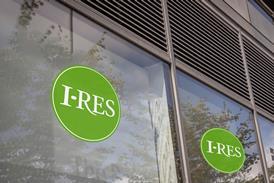The Extinction Rebellion protests last month brought huge swathes of London to a standstill and dominated the headlines, even pushing Brexit down the agenda for a few days.
Many politicians and industry leaders backed the protests – some even stood in line to get a picture with the climate change movement’s poster girl Greta Thunberg. However, one group was conspicuous by its absence: the property industry.
Given all the recent talk about social impact and environmental resilience, its silence was something of a surprise. Then again, the facts do not exactly paint the industry in a very green light.
A new framework document published by the UK Green Building Council (UKGBC) at the end of last month reveals that UK buildings account for around 30% of the UK’s carbon emissions – the majority caused by heating, cooling and electricity use. Embodied emissions from construction can account for as much as half the carbon impact associated with a building over its lifetime, it adds.
So is the UK property industry doing enough to tackle the climate change crisis? And if not, why not?
The consensus is that while many property companies have started to reduce their carbon footprints in recent years, a lot more needs to be done – and quickly.
The RICS global survey of commercial and construction market professionals, published last week, underscores the scale of the problem. It reveals that 47% of UK investors are not concerned by climate change risks (10.05.19).
So grave is the situation that Landsec’s sustainability insight director Edward Dixon said that the industry would “have to stop growth – or at least pull it back a bit – within around 12 years” if it is to deal with climate change (‘Landsec says industry must “stop growth” to tackle climate change’, PropertyWeek.com).
Key principles
There are other steps the industry should be taking to reduce its impact on the environment, says the UKGBC. For one, it should be committing to making new and existing buildings net zero carbon producing by 2050, in line with the aspirations of the Paris Agreement.
To that end, the new UKGBC framework offers guidance, sets out key principles to follow and outlines how such a claim should be measured and evidenced.
Although the target is laudable and the framework has been widely welcomed, the industry will need to overcome numerous hurdles to hit the UKGBC’s ambitious target.
“I think the big REITs that control big tracts of land and can integrate sustainability have got a much easier task than the average landlord owning an average building on the average street”
Basil Demeroutis, FORE Partnership
One issue is the disparate ownership of UK property. Basil Demeroutis, managing partner at FORE Partnership, argues that the larger propcos have a distinct advantage over smaller, individual operators.
“I think companies such as Landsec and British Land – the big REITs that control big tracts of land and can integrate sustainability – have got a much easier task than the average landlord owning an average building on the average street,” says Demeroutis.
That is not to say it is impossible for smaller landlords or individual asset owners to create greener buildings, as his company has demonstrated in Manchester, where it recently reached practical completion at the circa 80,000 sq ft Windmill Green office building – the city’s second BREEAM Outstanding building.
Smart technology
At the other end of the spectrum, AXA IM – Real Assets is developing a 1.4m sq ft scheme at TwentyTwo Bishopsgate in the heart of the City of London that features smart technology specifically designed to reduce the development’s environmental impact.
Harry Badham, UK head of development at AXA IM – Real Assets, says TwentyTwo’s automated fault detection and diagnosis system alone can achieve up to 20% energy savings across the scheme, which only uses energy from renewable sources.

He adds that the company is using TwentyTwo, which is a “big building with a big budget”, as a test bed for smart technology with a view to eventually rolling it out more widely. “We are looking at all our new buildings being smart buildings,” he says.
However, while significant inroads have been made by the likes of FORE and AXA IM, others have been slower on the sustainability uptake, notes Rory Bergin, sustainable futures partner at HTA Design.
“Some of our clients are starting to be asked by investors about the sustainability standards of their projects so they are in turn discussing sustainability standards with us, but it’s not particularly commonplace,” says Bergin.
Many are too short-termist, he adds: “It is a bit disappointing that people who are building buildings that are going to be around for 50 to 60 years are not thinking about the implications of this.
“We’ve got to crack the code on making the average building on the average street more carbon friendly. It has to be economic first and foremost.”
Basil Demeroutis, FORE Partnership
The problem is most of them are building to sell, so when the building is sold they are free of any responsibility.”
If new-builds are challenging, existing stock is even more so, because much of it is in poor condition. Yet it is more important than new-builds.
“New buildings make up 5% to 10% of stock year on year, maybe less,” explains Badham. “If we’re going to make a real difference to the amount of energy used in operational buildings, we have to focus on existing stock.”
Demeroutis agrees. “We’ve got to crack the code on making the average building on the average street more carbon friendly. It has to be economic first and foremost.
“You can’t just knock it down and rebuild and you can’t spend hundred of pounds per square foot refurbishing a building that doesn’t have that economic value.”
The industry is beginning to refurbish existing schemes but it is doing so at a slow pace, “so in terms of the road ahead we’re at the very start”, says Demeroutis.
Taking responsibility
That said, some companies are doing better than others in addressing climate change. SEGRO launched its responsibility strategy back in 2012, setting targets and key performance indicators up to 2020. The company says the strategy has had a significant impact and that just under a third of its property portfolio is now sustainably certified compared with just a handful of buildings when the strategy was launched seven years ago.
This year, it launched a new strategy that it hopes will enable it to “stretch itself a bit more”, says Ben Brakes, group sustainability manager at SEGRO.
The company now has three key targets. “We’ve challenged ourselves to reduce our carbon footprint by 40% by 2025,” says Brakes. “Our second target is for waste created by development; we’ve challenged ourselves to send nothing to landfill by 2025. And the third target is to reduce embodied carbon – the carbon inherently built into the material we use to build our buildings – by 20% by 2025.”
“We’ve challenged ourselves to reduce our carbon footprint by 40% by 2025”
Ben Brakes, SEGRO
The embodied carbon of buildings, which is a relatively new concept, is something “the whole real estate industry is going to have to get to grips with”, he contends.
Another big propco pursuing an ambitious sustainability programme is British Land. It is in the fourth year of a five-year strategy aimed at reducing carbon intensity and energy intensity by 55% and cutting embedded energy by 15%.
Cressida Curtis, British Land’s head of corporate affairs and sustainability, says the company is making “good strides” towards hitting these targets as the deadline approaches. “I wouldn’t say it’s a slam dunk, but we’re working hard asset by asset to get there,” she says.
Meadowhall success
One of the company’s major success stories has been Meadowhall shopping centre. Environmental considerations were at the heart of a recent refurbishment programme, says Curtis, enabling the centre to achieve a BREEAM ‘in use’ rating of ‘outstanding’. “I believe it is the first time a shopping centre in the UK has achieved it,” she says.
Hammerson is yet another company pushing hard on the environmental front. It aims to be net positive by 2030. Louise Ellison, the group’s head of sustainability, says she is constantly looking at new technologies that aid the sustainable management of the company’s assets.

“However, this isn’t just about throwing money at something,” she says. “You have to work out when you need to do it. Yes, a lot of stuff has been done [to our portfolio already], but our assets are existing assets.
“Some are old and they are complex assets, so it’s not as easy as saying ‘I’m going to have energy [efficient] lighting all over this asset’ because it might take a while to programme this in.”
Although managing existing assets can be challenging, easy wins are possible. Switching to renewable power sources is one option. Knight Frank this week announced it had signed a contract with Total Gas and Power to purchase 100% renewable energy for the properties it was managing through to 2021.
This initiative alone is expected to reduce its carbon dioxide output by more than 100,000 tonnes by 2021 – “the equivalent of taking nearly 17,000 cars off the road over the course of the contract”, the company says.
Regardless of the different options property companies are exploring, one thing is clear: inertia is not an option. Change is coming – in one form or another – whether the industry likes it or not.
“People aren’t considering the fact that they have a highly leveraged, immovable, illiquid asset like a building and there is a chance that by a wave of a magic wand and the introduction of a new [government] policy, that building might not be worth what you thought it was and you will end up with a stranded asset,” says Demeroutis.
Political threats
This threat was underlined last week when shadow chancellor John McDonnell warned UK companies that under Labour, if they failed to tackle climate change, they could be delisted from the London Stock Exchange. If such a policy were enforced, it could have a significant impact on REITs.
Demeroutis says that regardless of which political party is in power, the direction of travel when it comes to the environment is clear. “We all know what’s going to happen: if you own a building [with an EPC rating] in the letters that follow ABC, then you’re next. That’s why when we refurbish buildings, they are all A or B rated.”
The other potential legislative threat comes from the Task Force on Climate-related Financial Disclosures (TCFD), which was founded in late 2015 by the Financial Stability Board to “develop a set of voluntary, consistent disclosure recommendations for use by companies in providing information to investors, lenders and insurance underwriters about their climate-related financial risks”.
The TCFD is going to be a “game changer” for industries such as property, believes Curtis.
“We are seeing more interest [in sustainability] from investors, partly because of the TCFD and partly because more money is seeking sustainable responsible investment funds,” she says,
This latter was one factor behind FTSE Russell’s launch of the FTSE EPRA Nareit Green Index in December. The index assesses and ranks the property portfolios owned by real estate companies on two parameters: green building certification and energy usage.
‘Clear material risk’
“Increasingly investors are taking an interest in integrating climate change considerations into different asset classes,” says Fong Yee Chan, senior product manager, sustainable investment, at FTSE Russell. “Real estate is one of the asset classes where climate change poses a clear material risk, due to the long life and energy-intensive nature of the assets.”
Investors’ desire to put their money into assets that offer greater sustainability is slowly starting to push through a cultural change in the property sector.
“We are slightly moving away from just tick-boxing buildings and saying ‘it’s an EPC of this and a BREEAM of that’, and moving towards ‘what policies do we need [to introduce] to run the building efficiently?’” says Badham.
“It’s a life-long commitment to how you run the building and for us, energy and sustainability is a massive part of that.”
“If you don’t understand the climate risks of your assets, you are not carrying out your fiduciary risks properly and you will come unstuck”
Louise Ellison, Hammerson
Unfortunately, not all property companies share this ideology. “We are still constructing buildings that could easily be built to a much higher standard, but they aren’t and that increases the likelihood that in 20 years’ time, they will have to do an expensive upgrade of these buildings,” says Bergin.
Ellison adds: “Companies that continue to think this way need to wake up. Any business that has got assets it expects to continue operating and generating income from for the next 20 to 30 years has got to take this seriously.”
She believes that the class action lawsuits currently being pursued in the US against businesses for environmental damage will prompt more shareholders and pension funds to ask “hard questions” about the assets they have invested in.
“If you don’t understand the climate risks of your assets, you are not carrying out your fiduciary risks properly and you will come unstuck,” she warns.
Considerable change
The industry has a long way to go to reduce its environmental impact. That said, we should not underestimate how much has been achieved in a relatively short space of time, says Darryl Neate, director of sustainability at Oxford Properties, which has reduced its own carbon emissions by 9% since 2015 and aims to reduce emissions by 30% by 2025.
“Going forward, there needs to be a deep focus on carbon, which includes considering the source of your energy and zero-carbon buildings”
Darryl Neate, Oxford Properties
“Ten years ago, property companies didn’t have a strong grasp of their energy and carbon data, there were limited reduction targets in place and green building certification programmes like BREEAM and LEED were still in their infancy,” says Neate.
“All this has changed considerably in a positive direction. At the same time, there is a lot more to be done. Going forward, there needs to be a deep focus on carbon, which includes considering the source of your energy and zero-carbon buildings, and it is still relatively early days on both these fronts.”
It is inevitable that climate change will play a much stronger role in investment decisions – “most notably from the perspective of resilience”, he adds. To this end, Oxford Properties is “in the process of developing a methodology that will assess climate change resilience within our investment process”.
Any business that does not face up to the climate change challenge runs the risk of devaluing its property portfolio and finding it difficult to dispose of properties. If that’s not enough of an incentive for the property industry to ‘green up its act’, nothing is.

































No comments yet